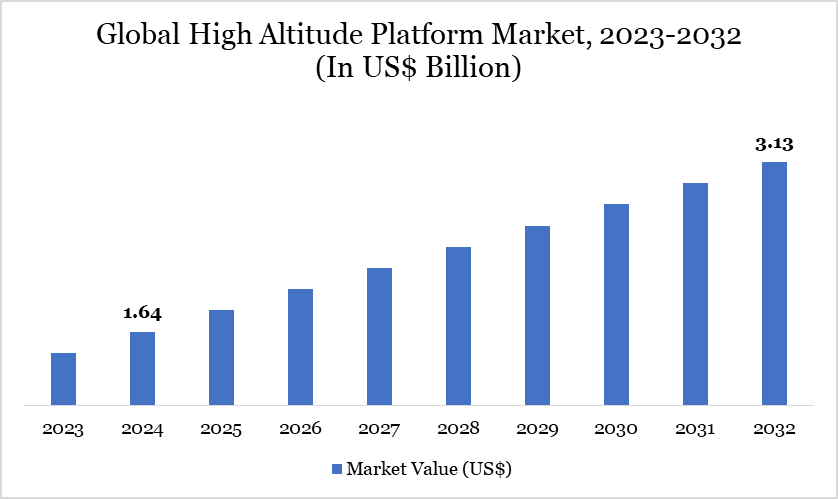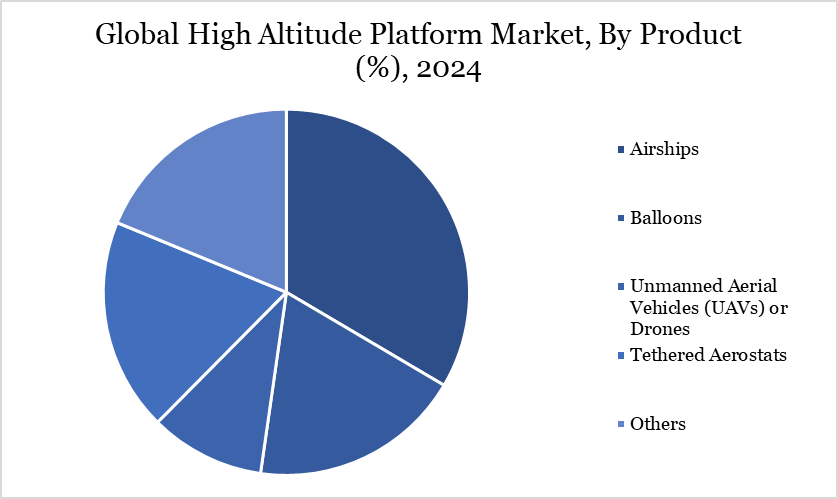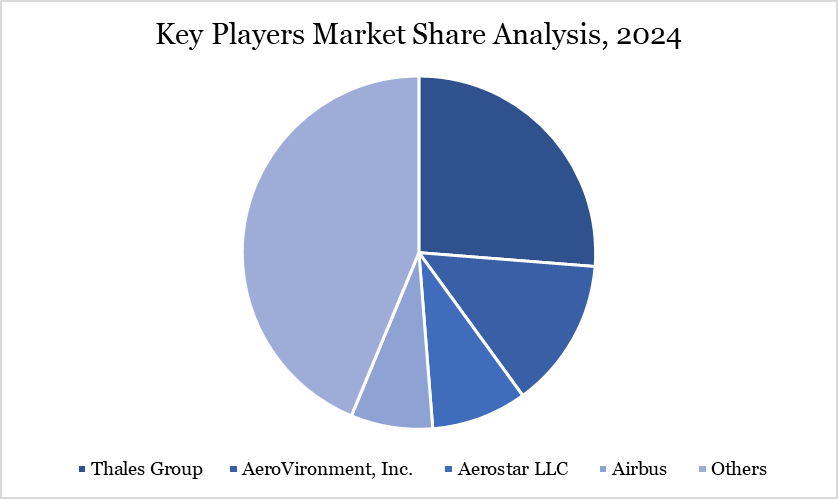High Altitude Platform Market Size
Global High Altitude Platform Market Size reached US$ 1.64 billion in 2024 and is expected to reach US$ 3.13 billion by 2032, growing with a CAGR of 8.40% during the forecast period 2025-2032.
The global high-altitude platform (HAP) market is witnessing significant growth, driven by increasing demand for cost-effective surveillance, communication, and remote sensing solutions. HAP systems, including airships, balloons, and UAVs, are gaining popularity as alternatives to satellites due to lower operational costs and rapid deployment. Technological advancements in lightweight materials, solar power, and payload capacity are enhancing platform efficiency. Rising defense and security applications, along with rural connectivity initiatives, are fueling market expansion.
High Altitude Platform Market Trend
A key trend in the high-altitude platform (HAP) development is the shift toward long-endurance, high-altitude surveillance systems as viable alternatives to satellites and UAVs. This reflects a broader trend of investing in persistent, cost-effective aerospace technologies for defense and strategic applications, emphasizing extended operational capabilities and reduced dependency on traditional space-based assets.
In September 2024, the National Aerospace Laboratories (NAL) in Bengaluru, India, developed a cutting-edge High-Altitude Platform (HAP) capable of long-duration surveillance and reconnaissance. Designed to operate continuously for up to 90 days, this advanced system offers a cost-effective alternative to satellites and UAVs. The HAP will ascend from southern India to an altitude of 23 km, surpassing the subtropical jet stream for uninterrupted monitoring of strategic zones.

Source: DataM Intelligence
For more details on this report, Request for Sample
Market Scope
| Metrics | Details |
| By Product | Airships, Balloons, Unmanned Aerial Vehicles (UAVs) or Drones, Tethered Aerostats, Others |
| By Payload | Communication Relays, Navigation Systems, Surveillance Systems, EO/IR Systems, Others |
| By Application | Connectivity and Communication, Intelligence, Surveillance, and Reconnaissance (ISR), Weather and Environmental Monitoring, Navigation and Remote Sensing, Others |
| By End-User | Government & Defense, Commercial, Research Institutions, Others |
| By Region | North America, South America, Europe, Asia-Pacific, Middle East and Africa |
| Report Insights Covered | Competitive Landscape Analysis, Company Profile Analysis, Market Size, Share, Growth |
High Altitude Platform Market Dynamics
Increasing Demand for Surveillance and Security
The increasing demand for surveillance and security is a major driver of the high-altitude platform (HAP) market. Governments and defense agencies worldwide are investing in HAPs to enhance border control, monitor strategic areas, and conduct persistent aerial surveillance without the high costs associated with satellites. HAPs offer the advantage of remaining airborne for extended periods, providing real-time data and high-resolution imagery for both military and civilian use. Their ability to hover over a fixed region makes them ideal for monitoring sensitive zones, urban environments, and remote areas.
As countries invest more in advanced surveillance solutions, HAPs are increasingly seen as a strategic tool for security, defense, and intelligence gathering, fueling market growth. For instance, in January 2025, the US Army advanced its ISR (Intelligence, Surveillance, and Reconnaissance) capabilities by testing spy drones launched from high-altitude platforms under the HADES (High Accuracy Detection and Exploitation System) program. These drones, such as the ALTIUS, are deployed from aircraft like the Bombardier 6500 to enhance surveillance reach while reducing risk to piloted missions.
Regulatory and Compliance Issues
Regulatory and compliance issues are significant restraints for the high-altitude platform Systems market as they complicate the approval process for commercial operations. Current airspace regulations are largely designed for traditional aircraft, creating challenges for HAPS that operate at stratospheric altitudes. Navigating complex and varied regulations across different countries increases the difficulty of achieving operations. Inconsistent regulations can delay deployments and limit market access.
The evolving nature of HAPS technology also requires adaptive regulatory frameworks, which are often slow to change, further hindering market growth. In February 2024, the HAPS Alliance recently addressed these challenges with the release of their "HAPS Certification Pathways" white paper, which highlights the unique regulatory hurdles HAPS faces and proposes a collaborative approach between industry stakeholders and regulators. The white paper emphasizes the need for flexible regulations that can adapt as the understanding of the stratospheric environment develops.
Market Segment Analysis
The high altitude platform market is segmented based on product, payload, application, end-user and region.

Source: DataM Intelligence
Airships hold Significant Share for their Cost-Effectiveness, Endurance, and Surveillance Capabilities
Airships hold a significant share in the high-altitude platform market due to their ability to provide stable, geostationary platforms for communication and surveillance. Airships can support heavy payloads, including communication equipment, sensors, and monitoring devices, making them ideal for providing connectivity in underserved regions. Moreover, they can operate in harsh weather conditions, unaffected by turbulence and storms. As the demand for reliable, high-speed internet and environmental monitoring grows, airships are becoming a key player in the expanding HAP market.
In 2024, US-based HAPS startup Sceye announced that it had completed its third test flight of a high-altitude airship, achieving key objectives such as automated pressure control, beyond-line-of-sight command, and reliable ascent. The solar-powered airship, operating at 65,000 feet, aims to provide connectivity to rural areas and track greenhouse gases, with Sceye's airship design offering geostationary capabilities and high payload capacity.
Geographical Analysis
North America's Market Dominance in High Altitude Platforms driven by Tech, Defense Investment, and Growing Demand for Communication and Surveillance
North America holds a significant share of the HAP market due to its advanced technological infrastructure, strong defense and aerospace sectors, and substantial investments in research and development. The region's high demand for communication services, especially in remote and underserved areas, drives the adoption of HAP systems. Additionally, the US military's use of HAPs for surveillance, reconnaissance, and communication purposes contributes to the market's growth.
As these platforms prove their value in addressing urgent needs, they foster greater confidence in their capabilities, leading to increased investments, partnerships, and further research in the region In October 2024, Aerospace startup Sceye partnered with NASA and the US Geological Survey (USGS) to deploy solar-powered High Altitude Platform Systems (HAPS) for monitoring wildfires and storms from the edge of space. The platforms, which hover at altitudes over 60,000 feet, offer a cost-effective alternative to satellites and small aircraft. This partnership, established through a 2021 research agreement, aims to test the endurance and capabilities of HAPS for climate monitoring and disaster response.
Technological Analysis
The high-altitude platform market has seen significant technological advancements, particularly with solar-powered platforms. These platforms leverage solar energy to provide sustainable, long-term operations in the stratosphere, reducing reliance on traditional fuel sources. Advancements in lightweight solar panel technology have improved energy efficiency, allowing platforms to stay aloft for extended periods.
In a significant move towards advancing High Altitude Platform Systems (HAPS), a consortium of Japanese businesses, led by NTT DOCOMO and Space Compass, along with Mizuho Bank and the Development Bank of Japan, announced that to would invest US$ 100 million in Airbus subsidiary AALTO. This strategic alliance, formalized with the Tokyo Stratospheric Declaration on May 29, 2024, aims to accelerate the commercialization of Zephyr, the world-leading solar-powered HAPS. The investment will support AALTO's roadmap for connectivity and Earth observation services in Japan, with a launch planned for 2026.
Major Players
The major players in the market include Thales Group, AeroVironment, Inc., Aerostar LLC, Airbus, IAI (Israel Aerospace Industries), SoftBank Corp., Saab AB, Sceye Inc., Northrop Grumman, ILC Dover LP and others.

Source: DataM Intelligence
Key Developments
- In February 2024, Indian conglomerate Larsen & Toubro announced plans to develop a solar-powered High Altitude Platform capable of staying airborne for up to 12 months. Targeting defense, telecommunications, and environmental monitoring, this platform aims to provide low-cost mass internet access and persistent surveillance capabilities.
Why Choose DataM?
- Data-Driven Insights: Dive into detailed analyses with granular insights such as pricing, market shares and value chain evaluations, enriched by interviews with industry leaders and disruptors.
- Post-Purchase Support and Expert Analyst Consultations: As a valued client, gain direct access to our expert analysts for personalized advice and strategic guidance, tailored to your specific needs and challenges.
- White Papers and Case Studies: Benefit quarterly from our in-depth studies related to your purchased titles, tailored to refine your operational and marketing strategies for maximum impact.
- Annual Updates on Purchased Reports: As an existing customer, enjoy the privilege of annual updates to your reports, ensuring you stay abreast of the latest market insights and technological advancements. Terms and conditions apply.
- Specialized Focus on Emerging Markets: DataM differentiates itself by delivering in-depth, specialized insights specifically for emerging markets, rather than offering generalized geographic overviews. This approach equips our clients with a nuanced understanding and actionable intelligence that are essential for navigating and succeeding in high-growth regions.
- Value of DataM Reports: Our reports offer specialized insights tailored to the latest trends and specific business inquiries. This personalized approach provides a deeper, strategic perspective, ensuring you receive the precise information necessary to make informed decisions. These insights complement and go beyond what is typically available in generic databases.
Target Audience 2025
- Manufacturers/ Buyers
- Industry Investors/Investment Bankers
- Research Professionals
- Emerging Companies